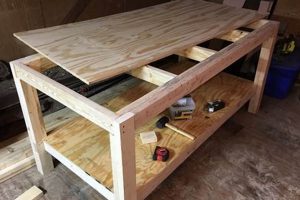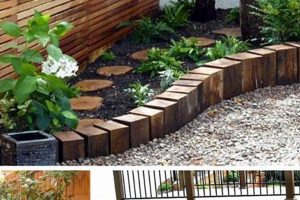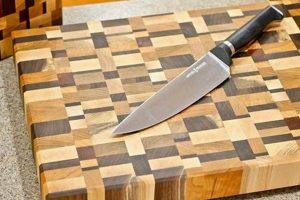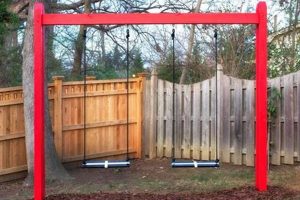A structure, frequently smaller than a typical dwelling, crafted primarily from timber and assembled by the individual or homeowner, falls under the category of self-constructed wooden shelters. These projects range from simple birdhouses and playhouses to more complex garden sheds and cabins, all built with a focus on personal construction and customization.
Engaging in such construction offers various advantages, including cost savings compared to purchasing pre-built alternatives. The process allows for complete personalization, adapting the structure to specific needs and aesthetics. Historically, this type of self-building represents a tradition of self-sufficiency and resourcefulness, empowering individuals to create functional spaces tailored to their individual requirements. This process fosters skills development in carpentry, design, and problem-solving.
The following sections will delve into the diverse types of these projects, the essential tools and materials required for successful completion, and a step-by-step guide to planning and executing a typical small-scale timber construction. Furthermore, the considerations related to safety, sustainability, and regulatory compliance will be examined to ensure responsible and fulfilling project outcomes.
Essential Guidance for Self-Constructed Timber Structures
This section provides crucial advice for individuals undertaking the construction of their own timber-based structures, ensuring both the longevity and structural integrity of the final product.
Tip 1: Thoroughly Plan the Project: A detailed blueprint, encompassing precise measurements and material requirements, is paramount. Inadequate planning frequently results in increased costs, wasted materials, and structural deficiencies.
Tip 2: Select Appropriate Timber: The choice of wood significantly impacts the structure’s durability. Pressure-treated lumber is recommended for ground contact, while naturally rot-resistant species, such as cedar or redwood, are suitable for exterior applications. Prioritize kiln-dried wood to minimize warping and shrinkage.
Tip 3: Employ Accurate Cutting Techniques: Precision is crucial for tight-fitting joints and a structurally sound frame. Utilize accurate measuring tools, sharp saws, and consider using jigs or templates to ensure consistent cuts. Practice cuts on scrap material before working with the final pieces.
Tip 4: Utilize Appropriate Fasteners: The selection of screws, nails, or bolts should be based on the specific application and load requirements. Galvanized or stainless-steel fasteners are recommended for exterior use to prevent corrosion.
Tip 5: Ensure Proper Drainage: Water is a primary cause of wood decay. Implement design features that facilitate effective water runoff, such as sloping roofs, adequate overhangs, and well-drained foundations. Consider applying water repellent sealants.
Tip 6: Apply Protective Finishes: Regularly applying paint, stain, or sealant protects the timber from the elements, extending its lifespan. Select finishes appropriate for the wood type and intended use. Inspect and reapply finishes as needed, typically every one to three years.
Tip 7: Adhere to Local Building Codes: Before commencing construction, research and comply with all applicable local building codes and zoning regulations. Permits may be required, and inspections may be necessary at various stages of the project.
Implementing these practices enhances the durability and aesthetic appeal of the final timber structure. Diligence in these areas is paramount for a successful and enduring outcome.
The concluding section will provide information regarding sustainable practices and long-term maintenance strategies for such structures.
1. Planning & Design
Effective planning and design serve as the bedrock upon which any successful self-constructed timber dwelling project is built. This phase establishes the project’s scope, defines aesthetic parameters, and ensures structural soundness before any physical construction begins, mitigating risks and maximizing resource utilization.
- Blueprint Development
Blueprint development involves the creation of detailed architectural plans that specify dimensions, materials, and construction methods. A well-defined blueprint acts as a central reference point, minimizing errors during construction. For example, a blueprint might detail the precise angle of roof rafters to ensure proper water runoff, or the spacing of support beams to meet load-bearing requirements.
- Spatial Layout Optimization
Spatial layout optimization concerns the efficient and functional arrangement of interior and exterior spaces. This includes considerations such as natural light access, ventilation, and the placement of utilities. An optimized layout ensures that the resulting structure meets the specific needs of its intended use, whether it is a storage shed, a playhouse, or a small cabin.
- Material Estimation & Budgeting
Accurate material estimation is critical for controlling project costs. This involves calculating the precise quantities of lumber, fasteners, roofing materials, and other necessary components. By creating a detailed budget based on material estimates, the project can remain financially viable and avoid unexpected expenses. An inaccurate estimate can lead to delays, cost overruns, and potential abandonment of the project.
- Compliance with Local Regulations
Navigating local building codes and zoning regulations is an essential aspect of planning and design. Failure to comply with these regulations can result in fines, legal action, and even the forced demolition of the structure. This facet involves researching permit requirements, setback distances, height restrictions, and other relevant ordinances before construction commences.
In conclusion, the Planning & Design phase is not merely a preliminary step; it is an integral component that dictates the success of the entire project. By emphasizing meticulous blueprints, optimized spatial layouts, precise material estimations, and stringent code compliance, individuals undertaking these builds can significantly increase their chances of creating functional, aesthetically pleasing, and legally sound timber structures.
2. Material Selection
The careful selection of materials stands as a critical determinant in the success and longevity of any self-constructed wooden house. This process directly impacts structural integrity, resistance to environmental factors, aesthetic appeal, and overall cost-effectiveness.
- Wood Species and Properties
The choice of wood species is fundamental. Different woods possess varying levels of strength, durability, and resistance to decay. For example, pressure-treated lumber is often employed for ground contact due to its enhanced resistance to rot and insect infestation. Cedar and redwood offer natural resistance to decay and are suitable for exterior siding. Conversely, softer woods may be appropriate for interior framing where structural demands are less stringent. The selection should align with the specific requirements of each component of the wooden house.
- Fasteners and Connectors
Fasteners, including nails, screws, and bolts, play a vital role in securing the wooden structure. The type and quality of fasteners must be appropriate for the wood species and the anticipated loads. Galvanized or stainless-steel fasteners are recommended for exterior applications to prevent corrosion. The size and spacing of fasteners directly impact the structural integrity of connections between wooden members.
- Finishes and Protective Coatings
Protective coatings, such as paints, stains, and sealants, serve to shield the wood from moisture, ultraviolet radiation, and other environmental stressors. The selection of a suitable finish extends the lifespan of the wooden house by preventing decay, warping, and cracking. The finish should be compatible with the wood species and the intended aesthetic.
- Insulation and Weatherproofing
Insulation materials and weatherproofing measures are crucial for maintaining comfortable interior conditions and minimizing energy consumption. Proper insulation reduces heat loss in colder climates and heat gain in warmer climates. Weather stripping and caulking prevent air and water infiltration, further enhancing energy efficiency and protecting the structure from the elements. The type and amount of insulation should be appropriate for the climate and the intended use of the wooden house.
The integrated application of appropriate material selection principles directly influences the structural resilience, environmental adaptability, and long-term maintenance requirements of the self-constructed wooden house. Informed decisions in this area contribute significantly to a sustainable and functional outcome.
3. Construction Techniques
The execution of a self-constructed wooden house is fundamentally dependent on the application of sound construction techniques. These methods dictate the structural integrity, aesthetic quality, and overall durability of the completed structure.
- Framing and Joinery
Framing constitutes the skeletal structure of the house, typically employing techniques such as stud wall construction, post-and-beam systems, or timber framing. Precise joinery, including mortise-and-tenon, dovetail, or lap joints, ensures robust connections between framing members. Improper framing can lead to structural instability, while deficient joinery may result in weakened connections prone to failure under stress. An example includes utilizing accurately measured and cut lumber to construct a perfectly square frame, which in turn, ensures that walls are plumb and level. Such precision is vital for the subsequent installation of doors, windows, and finishes.
- Sheathing and Cladding
Sheathing provides a structural skin that reinforces the frame and offers a substrate for cladding materials. Plywood or oriented strand board (OSB) are commonly used for sheathing. Cladding, such as wood siding, shingles, or metal panels, protects the structure from the elements and contributes to its aesthetic appearance. Improperly installed sheathing can compromise the structural integrity of the walls, while poorly applied cladding can lead to water damage and premature deterioration. For instance, overlapping wood siding correctly ensures water runoff, preventing moisture from penetrating the wall assembly.
- Roofing and Weatherproofing
Roofing protects the structure from precipitation and insulates against temperature extremes. Roofing materials include asphalt shingles, metal roofing, or wood shakes. Proper installation, including adequate underlayment and flashing, is crucial for preventing leaks and water damage. Weatherproofing measures, such as sealing gaps and cracks, minimize air infiltration and enhance energy efficiency. A well-sealed roof, with correctly installed flashing around chimneys and vents, prevents water from seeping into the structure and causing rot or mold.
- Foundation and Footings
The foundation provides a stable base for the wooden house and distributes its weight to the underlying soil. Common foundation types include concrete slabs, pier and beam systems, or crawl spaces. Footings, typically made of concrete, support the foundation walls or piers. Inadequate foundations or footings can lead to settling, cracking, and structural failure. For example, properly sized and reinforced concrete footings prevent the structure from sinking or shifting due to soil movement or inadequate load bearing capacity.
These construction techniques, when diligently applied, determine the longevity and habitability of the self-constructed wooden house. Neglecting these principles can result in compromised structural integrity, increased maintenance costs, and reduced lifespan of the dwelling.
4. Code Compliance
The construction of a self-assembled timber dwelling is inextricably linked to code compliance, establishing a cause-and-effect relationship where adherence to regulations directly affects the legality and safety of the structure. Building codes are designed to ensure public safety and welfare by setting minimum standards for structural integrity, fire safety, and sanitation. Therefore, disregarding code compliance when building a self-constructed wooden house can lead to significant legal and safety ramifications. For instance, failure to meet fire-resistance standards for wall assemblies could result in a dwelling being deemed uninhabitable or unsafe in the event of a fire, endangering occupants. Similarly, improper electrical wiring, not in accordance with electrical codes, increases the risk of electrical fires. A failure to obtain necessary permits can lead to fines, legal action, or even the forced removal of the structure.
The importance of code compliance extends beyond legal considerations to impact the long-term viability and value of the timber dwelling. A structure built to code is more likely to withstand environmental stressors, resist decay, and maintain its structural integrity over time. For example, adhering to codes regarding foundation depth and construction in areas prone to frost heave prevents structural damage caused by ground freezing and thawing. Correctly installed insulation, as mandated by energy codes, lowers utility costs and increases comfort. Furthermore, a structure that adheres to all building codes will typically appraise higher in value than one that does not, facilitating future sales or refinancing.
In summary, code compliance is an indispensable component of any self-constructed wooden house project. It is not merely a bureaucratic hurdle but a critical process for ensuring safety, legality, and long-term value. Challenges often arise from the complexity of building codes and the variance across jurisdictions. Thorough research, consultation with local building officials, and potentially engaging qualified professionals are vital steps in navigating the regulatory landscape and successfully integrating code compliance into the building process. This ensures a safe, habitable, and legally sound timber dwelling.
5. Safety Protocols
The integration of comprehensive safety protocols is paramount during the construction of a self-built wooden house. These protocols serve to mitigate risks associated with the inherent hazards of construction activities, protecting individuals involved and ensuring a safe working environment.
- Personal Protective Equipment (PPE)
The consistent use of appropriate PPE is a fundamental safety measure. This includes items such as safety glasses to protect against flying debris, hard hats to guard against head injuries from falling objects, work gloves to prevent cuts and abrasions, and steel-toed boots to protect feet from impacts and punctures. The specific PPE required will vary depending on the task being performed. For example, when operating power tools, hearing protection is essential to prevent noise-induced hearing loss. Neglecting PPE significantly increases the risk of injury.
- Power Tool Safety
Power tools are indispensable for many construction tasks, but they also pose significant hazards if used improperly. Thorough understanding of the operating instructions for each tool is essential, as is regular inspection to ensure they are in good working order. Safety guards should never be removed or disabled. Ground fault circuit interrupters (GFCIs) should be used to protect against electric shock. Work areas must be kept clear of obstructions, and adequate lighting should be provided. For instance, a circular saw should be equipped with a functional blade guard and operated with both hands to maintain control. Failure to adhere to these practices increases the risk of severe injuries, including lacerations, amputations, and electrocution.
- Ladder and Scaffolding Safety
Working at heights presents a substantial risk of falls. Ladders and scaffolding must be erected and used in accordance with safety regulations. Ladders should be placed on stable surfaces and extended at least three feet above the landing point. Scaffolding must be level, stable, and equipped with guardrails and toeboards. Workers should never overreach or carry heavy objects while on ladders or scaffolding. A common mistake is using a ladder that is too short, forcing the worker to stand on the top rung, which significantly increases the risk of a fall.
- Material Handling and Storage
Improper handling and storage of materials can lead to injuries and accidents. Heavy materials should be lifted using proper techniques, such as bending at the knees and keeping the back straight. Materials should be stored in a stable and organized manner to prevent them from falling or creating tripping hazards. Hazardous materials, such as paints and solvents, should be stored in accordance with manufacturer’s instructions and kept away from sources of ignition. For example, lumber should be stacked neatly and securely to prevent it from toppling over, and sharp objects should be stored in designated containers.
These multifaceted safety protocols are indispensable for mitigating risks and ensuring a safe construction environment when building a self-constructed wooden house. Consistent adherence to these measures protects individuals from preventable injuries, promotes a productive work environment, and ultimately contributes to the successful completion of the project.
6. Maintenance
Maintenance is an intrinsic component of self-constructed wooden dwellings, forming a direct causal relationship with the structure’s longevity and overall value. The inherent properties of wood necessitate consistent upkeep to counteract environmental factors and prevent deterioration. This includes addressing moisture intrusion, insect infestation, and ultraviolet radiation damage, all of which can compromise the integrity of a self-built wooden house. The failure to implement a proactive maintenance regimen invariably leads to accelerated decay, structural weakening, and ultimately, costly repairs or even complete failure of the structure. For instance, neglecting to reapply sealant to exterior siding allows water to penetrate the wood, leading to rot and potentially compromising the structural frame. Similarly, failing to address termite infestations promptly can result in extensive damage, requiring significant repairs to load-bearing members.
The specific maintenance requirements vary depending on the climate, the type of wood used, and the construction techniques employed. Regular inspections are crucial to identify potential problems early. These inspections should focus on areas prone to moisture accumulation, such as roofs, gutters, and foundations. Promptly addressing any identified issues, such as leaks, cracks, or signs of insect activity, is essential to prevent further damage. Practical applications of maintenance include the periodic reapplication of protective coatings, such as paint, stain, or sealant, to shield the wood from the elements. These coatings act as a barrier against moisture and UV radiation, extending the lifespan of the wood. Furthermore, regular cleaning of gutters and downspouts prevents water from backing up and causing damage to the roof and siding. Proper ventilation in crawl spaces and attics helps to reduce moisture levels and prevent the growth of mold and mildew.
In summary, the ongoing maintenance of a self-built wooden house is not an optional consideration but a fundamental requirement for ensuring its durability and preserving its value. The challenges lie in understanding the specific maintenance needs of the structure and implementing a consistent and proactive approach. By prioritizing maintenance, individuals can safeguard their investment, prevent costly repairs, and enjoy the benefits of their self-constructed wooden dwelling for years to come. This understanding is essential for aligning expectations with the ongoing responsibilities associated with this type of construction.
Frequently Asked Questions
This section addresses common inquiries and misconceptions regarding the planning, construction, and maintenance of do-it-yourself wooden houses. The information provided is intended to offer clarity and informed guidance.
Question 1: Is prior carpentry experience required to undertake a self-constructed timber dwelling project?
While prior carpentry experience is beneficial, it is not strictly mandatory. A willingness to learn, coupled with diligent research and careful planning, can compensate for a lack of formal training. However, complex projects may necessitate the involvement of experienced professionals for critical structural components.
Question 2: What are the primary considerations for selecting a suitable location for a wooden house?
Key factors include soil stability, drainage, sunlight exposure, and proximity to utilities. The location should also comply with local zoning regulations and building codes. A geotechnical survey may be necessary to assess soil conditions and ensure adequate foundation support.
Question 3: Are self-constructed wooden houses insurable?
Securing insurance for a self-constructed wooden house can be challenging but not impossible. Insurance companies typically require detailed documentation of the construction process, including permits, inspections, and materials specifications. Meeting all applicable building codes and demonstrating sound construction practices increases the likelihood of obtaining coverage.
Question 4: What are the common pitfalls to avoid during the construction process?
Frequent mistakes include inadequate planning, inaccurate measurements, improper fastening techniques, and neglecting to obtain necessary permits. Thorough research, meticulous attention to detail, and adherence to safety protocols are crucial for avoiding these pitfalls.
Question 5: How can the environmental impact of a self-constructed timber dwelling be minimized?
Sustainable practices include using sustainably harvested lumber, employing energy-efficient design principles, incorporating recycled materials, and minimizing waste during construction. Implementing rainwater harvesting and solar power systems further reduces the environmental footprint.
Question 6: What are the long-term maintenance requirements for a wooden house?
Routine maintenance involves regular inspections for signs of damage or decay, prompt repairs of any identified issues, and periodic reapplication of protective coatings. Proper ventilation and moisture control are also essential for preventing rot and mold growth.
In summary, the successful completion of a self-constructed timber dwelling hinges on meticulous planning, adherence to safety protocols, and a commitment to ongoing maintenance. The information provided aims to equip individuals with the knowledge necessary to make informed decisions and navigate the challenges associated with this endeavor.
The following section will present a conclusion summarizing key points.
Conclusion
The preceding exploration has illuminated the multifaceted aspects of self-constructed timber dwellings, emphasizing the critical interplay between planning, material selection, construction techniques, code compliance, safety protocols, and ongoing maintenance. A comprehensive understanding and diligent application of these principles are essential for successful project execution.
The construction of a diy wooden house represents a significant undertaking, demanding careful consideration and commitment. While the potential for cost savings and personalized design is considerable, the responsibility for structural integrity and long-term durability rests solely with the builder. Prospective constructors should thoroughly assess their capabilities, seek expert guidance when necessary, and prioritize safety at every stage to ensure a sustainable and legally compliant outcome. The future of this construction method hinges on responsible practices and a dedication to quality craftsmanship.







